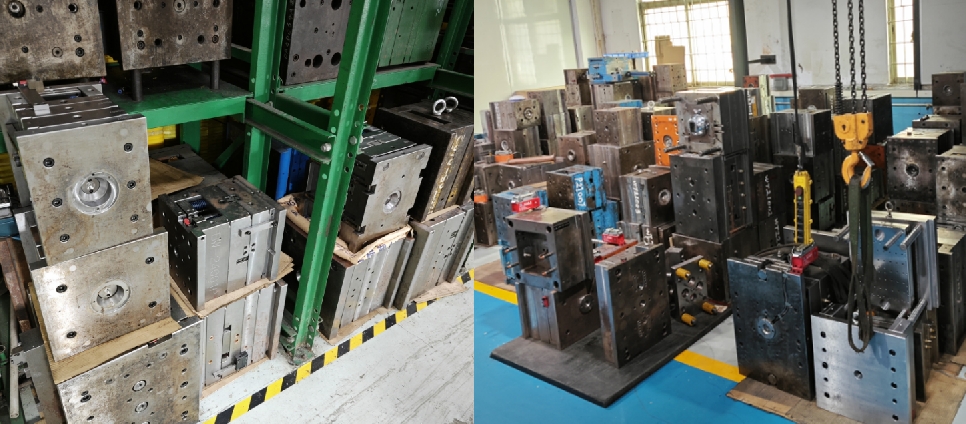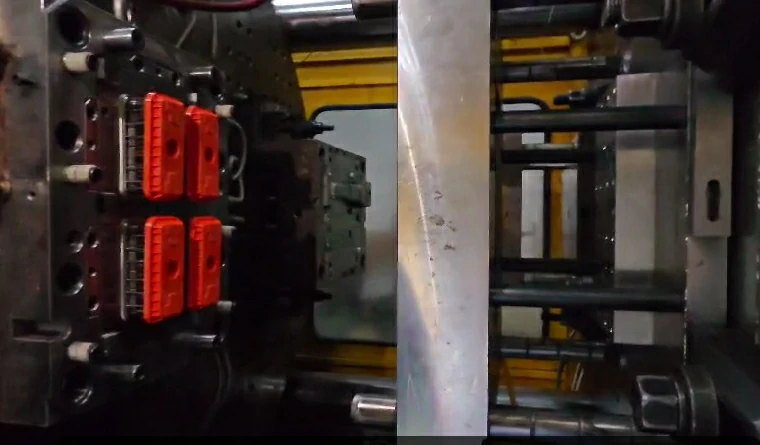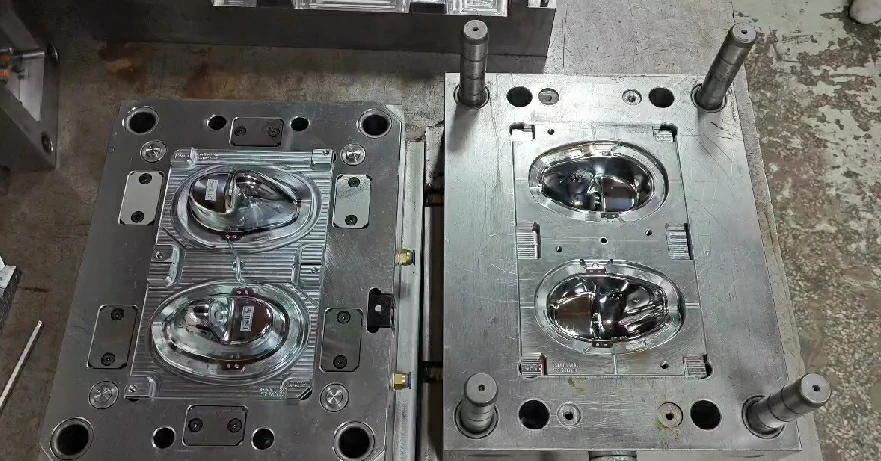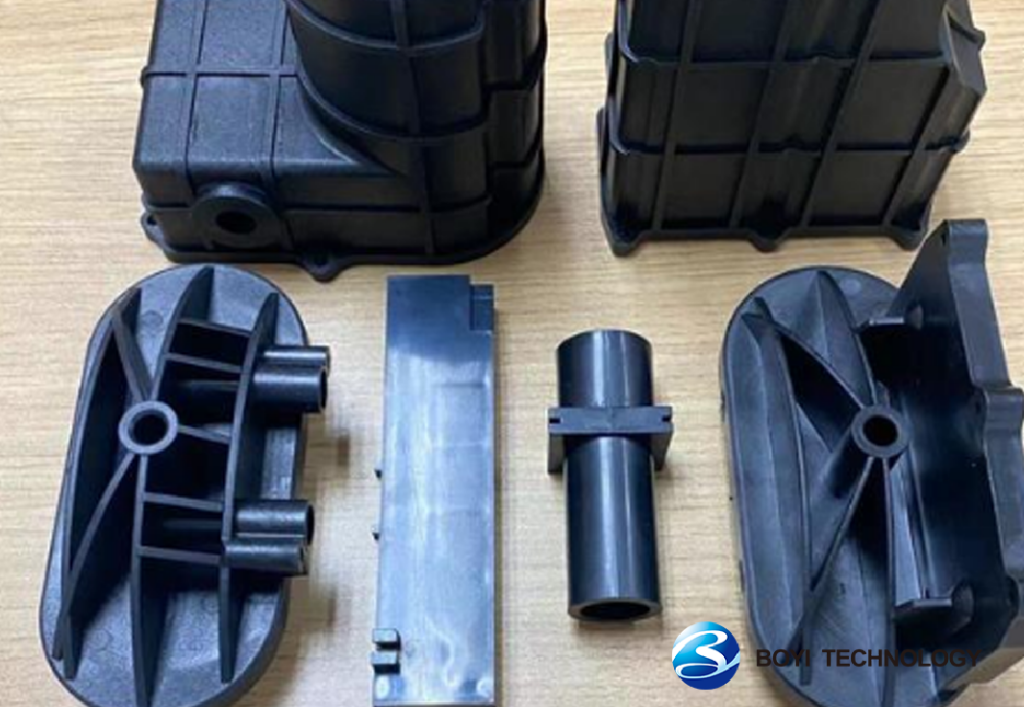
Choosing the right mold material is crucial in the pursuit of high-quality injection molding. An experienced plastic injection molding company can offer professional advice to help you make the best choice among various materials, molding techniques, and 3D printing alternatives.
In these decisions, your injection molding partner may offer two common mold materials: aluminum or steel. But do you understand the core differences between them and how these differences can impact your project?
This article will delve into the comparison and differences between aluminum molds and steel molds in the injection molding process, aiming to help you better understand the characteristics of both materials so that you can make wiser decisions in actual production.
Aluminum Molds
Aluminum is renowned for its lightweight, flexibility, and high heat resistance, making aluminum molds a significant advantage in the field of plastic injection molding. Compared to steel molds, aluminum molds are more cost-effective to produce, making them excel in low-volume manufacturing, particularly suited for producing hundreds to thousands of units.
Due to its excellent thermal conductivity, aluminum molds can rapidly and evenly cool after each production cycle. This not only enhances production efficiency but also helps reduce defects, waste, and scrap rates during the injection molding process.
However, the flexibility of aluminum molds also comes with certain limitations. While this flexibility makes aluminum molds easier to machine and modify during manufacturing, it also restricts their application in complex designs.
As the complexity of designs increases, the accuracy and durability of aluminum molds may be compromised. Additionally, aluminum molds have relatively lower durability compared to steel molds; they are more prone to wear and tear over prolonged or continuous production runs, making them unsuitable for high-volume production.
Nevertheless, the advantages of aluminum molds in low-volume production are still significant. Their quick turnaround time (standard lead time can be as fast as 7 days) and lower manufacturing costs (starting mold price is around $1000) make aluminum molds an ideal choice for many businesses.
Due to its rapid delivery and lower costs, aluminum molds are an ideal choice for rapid prototyping and new product testing stages. Additionally, aluminum molds offer the advantages of simplified mold design and reduced manufacturing time and costs, making them the preferred choice for many manufacturers.
In the manufacturing process of aluminum molds, Bo Yi offers the option of single-cavity and multi-cavity molds to meet the requirements of different sizes and complexities of parts. Depending on the size and complexity of the parts, businesses can choose 1, 2, 4, or 8 cavity molds to meet production needs.
Furthermore, we support the use of a variety of thermoplastic and thermosetting materials, such as ABS, PC, PP, LCP, POM, and over 100 different materials including liquid silicone rubber, to meet the needs of different industries and applications.
We are committed to providing customers with maintenance-free and lifetime replacement guarantees for mold damage, ensuring optimal performance and reliability during the use of aluminum molds. Additionally, we are dedicated to improving heat dissipation design, reducing cluttered cooling channels to enhance the overall performance and lifespan of the molds.
Put your plastic parts into production today
All uploads are secure and confidential.
Steel Molds
Steel molds, with their outstanding durability and stability, have become the preferred choice for high-volume continuous production. Although the initial investment cost of steel molds may be higher than aluminum molds, their economy gradually becomes apparent in long-term high-volume production environments.
As production quantities increase, the durability and stability of steel molds can significantly reduce the cost per part. Additionally, steel molds support multi-cavity designs, enabling efficient production of multiple parts and further enhancing production efficiency.
Meanwhile, the hardness of steel enables the manufacturing of more complex and intricate mold designs, meeting high precision and demanding manufacturing requirements.
Due to the relatively higher price of steel and the high precision machining requirements in the manufacturing process of steel molds, the initial investment cost of steel molds is typically higher. Additionally, the heating and cooling speeds of steel molds are relatively slower, which can increase production time and costs.
Therefore, when choosing steel molds, manufacturers need to consider factors such as their production scale, production cycle, and budget comprehensively.
Why Need Aluminum or Steel Mold for Injection Molding?
Why are aluminum or steel molds preferred in injection molding processes? Well, Molds are not just simple tools; they are, in fact, precise replicas of product shapes and sizes. Therefore, they must have precise cavity designs to ensure that the produced plastic parts match the expected shapes and dimensions perfectly.
Aluminum and steel molds, with their excellent processing capabilities, can easily achieve complex cavity designs, ensuring that the produced parts have high geometric precision. That’s why we need them.
Both aluminum and steel materials not only have high strength to withstand the immense pressure generated during the injection molding process but also possess excellent thermal conductivity. This allows them to quickly transfer heat away from the plastic, ensuring uniform cooling within the mold.
Aluminum and steel molds also exhibit outstanding corrosion resistance, maintaining stable performance over prolonged periods of use. This means longer mold lifespans, reducing the frequency of mold replacements and subsequently lowering production costs.

Comparing Aluminum vs Steel Molds
Aluminum molds and steel molds each have their unique characteristics and advantages. The following are some comparisons between the two:
Costs
Aluminum molds often exhibit lower prices compared to steel molds. Although the raw material cost of aluminum may be slightly higher than steel, the manufacturing cost of aluminum molds is typically lower due to aluminum’s ductility, ease of processing, and higher material availability.
While aluminum molds have the advantage in initial investment, the overall value and return on investment of molds are not solely determined by price. In certain cases where high precision and durability molds are required, steel molds may be more suitable.
Machinability and Modification Ease
Steel molds, due to their high hardness and rigidity, undergo relatively complex and time-consuming machining processes, while aluminum molds, with their softer material, are easier to process, significantly reducing mold production time and costs.
Due to the soft nature of aluminum, it can be easily machined and modified to accommodate different production needs. In contrast, the hardness and rigidity of steel molds, while ensuring their durability, also increase the difficulty of machining and modification, requiring more time and specialized equipment.
Therefore, in environments that prioritize rapid iteration and flexible adjustments in production, aluminum molds are a worthy consideration as a high-quality choice.
Cost Per Part
When evaluating the cost of each part, the key lies in the production scale and expected runtime.
For low-volume (ranging from 100 to 1000) or short-term production orders, aluminum molds have the advantage due to their lower upfront costs, helping to quickly recoup the cost of each part.
However, if the molds are to be used for high-volume (ranging from hundreds of thousands to millions) or long-term production, although the initial investment in steel molds is higher, their outstanding durability and stability can amortize these costs over the long run. Over time, the cost of each part will gradually decrease, resulting in higher returns on investment in the long term.
Therefore, when choosing between aluminum and steel molds, it is important to carefully assess your production needs and long-term strategies.
Durability and Wear Resistance
The high strength, hardness, and fatigue resistance of steel enable it to withstand long-term injection pressures and millions of molding cycles, demonstrating excellent durability and sustainability.
For businesses planning to produce only a small quantity of injection molded parts annually, aluminum molds may be a more cost-effective choice. As mentioned, aluminum molds are the optimal unit cost choice for reducing production volumes.
In contrast, aluminum molds, due to their rapid thermal expansion and contraction and softer material characteristics, exhibit relatively poorer durability and wear resistance. Additionally, the softer surface of aluminum is more susceptible to scratches and dents.
Therefore, steel molds have the advantage in durability and wear resistance, making them suitable for high-volume production, while aluminum molds are more suitable for low-volume production needs.
Time To Manufacture
Due to the material characteristics of aluminum, aluminum molds are easier to machine and manufacture, resulting in shorter overall manufacturing times. Typically, aluminum molds can be ready in as fast as 15 days, while steel molds may take up to 30 days to complete.
Thermal Properties and Cooling Times
Aluminum is an excellent thermal conductor, with a thermal conductivity rate of approximately 237 W/m/K, nearly five times that of steel. This means that aluminum molds can achieve the required working temperature more rapidly during the injection molding process and also cool down quickly after production is completed.
While steel molds have slower cooling speeds, this also aids in better temperature control and cooling rates. In certain applications that require finer temperature control, steel molds may have an advantage.
Therefore, aluminum molds surpass steel molds in heating and cooling performance, enabling faster production of plastic parts.

Advantages and Disadvantages of Aluminum vs Steel Molds
Understanding the advantages and disadvantages of aluminum molds and steel molds can help you determine which mold better meets the molding requirements.
Advantages of Aluminum Molds
- Low manufacturing costs and fast processing speed.
- Shorter manufacturing cycles compared to steel molds, allowing for quick production startup.
- Lightweight, facilitating easy handling, installation, and storage.
- Adaptable to product design changes or issues during production.
- Capable of rapid and uniform heating and cooling, reducing production cycles.
Disadvantages of Aluminum Molds
- Lower durability, capable of withstanding only a limited number of injection cycles.
- Poor resistance to high temperatures, unsuitable for injection molding of high melting point resins.
- Relatively soft surface, susceptible to wear and scratches.
- Prone to expansion at high temperatures, potentially leading to dimensional instability.
Advantages of Steel Molds
- Has a longer lifespan, capable of withstanding millions of injection cycles.
- Excellent strength and hardness, able to withstand high pressures and temperatures.
- Mold surface is hard, less susceptible to scratches and dents.
- High dimensional stability at elevated temperatures, ensuring product accuracy and quality.
- Can withstand high temperatures, suitable for injection molding various types of resins, including high melting point resins.
Disadvantages of Steel Molds
- High manufacturing costs, adding to initial investment pressure.
- Longer manufacturing cycles, unsuitable for rapid turnover production needs.
- The material of steel molds is hard, making modifications and adjustments difficult, expensive, and time-consuming once the design is completed and machined.
When to Choose Aluminum Molds? Steel Molds?
When choosing between aluminum molds or steel molds, multiple factors need to be considered comprehensively to ensure the selection of the most suitable mold material for your production needs.
If your part quantities have not yet reached the millions and you need to produce parts quickly according to demand while avoiding high mold investments until the part design is fully validated, then using aluminum molds for low-volume injection molding is a good choice.
If you are still unsure about the choice between aluminum and steel molds, we can assist you in selecting the most suitable mold based on your requirements and specifications. BoYi provides free Design for Manufacturability (DFM) audits for each injection molding project, with feedback provided within 2 hours. This means you can conduct multiple design reviews within the time of receiving preliminary quotes, and once decided, molds can be swiftly put into production.
If you are looking for a reliable injection molding partner, BoYi will be your ideal choice. We are committed to providing injection molding services that exceed customer expectations. Feel free to contact us for a quick quote and let us help you quickly produce high-quality prototypes and parts.
Put your plastic parts into production today
All uploads are secure and confidential.
Conclusion
In conclusion, the choice between aluminum and steel molds in plastic injection molding depends on various factors such as production volume, lead time, budget, part complexity, and material requirements.
FAQ
The choice between aluminum and steel tooling depends on specific needs.Steel is more durable, while aluminum is cost-effective and versatile. Aluminum may wear out faster, but it offers benefits for smaller or quick production runs.
Aluminum molds are used for production of blow molds, structural foam molds, and injection molds. Materials like 7050 aluminum alloy are suitable for thinner molds up to 8 inches, while 6061-T651 is used for larger and lower-volume molds.
Aluminum molds typically last between 3,000 to 10,000 production cycles, depending on usage and maintenance. With a single cavity, an aluminum mold can produce up to 10,000 parts.
Tagged: Injection Molding Guide



